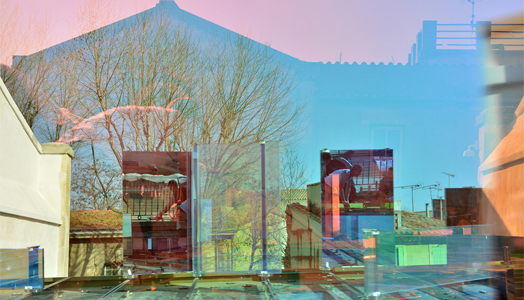Info & Images: Courtesy Fluor Architecture
Nominated for the Mies van
der Rohe Award 2015 by the European Union Prize for Contemporary Architecture,
the rehabilitation of the Vincent van Gogh Foundation at Arles, France is a beautiful
exercise that transcends the fine boundaries between art and architecture.
In the words of art critic
and co-editor of the Documents d’artistes project, Guillaume Mansart, “Born
from a complex web of desires, the architectural design of the Vincent van Gogh
Foundation . . . . . . invents a
style forged from combination. Organizing heterogeneous spaces, interweaving
contemporary works of art and the museographic requirements of conservation,
recomposing historical elements and inventing new forms, the architecture
multiplies ways of reflecting. The architecture catalyzes intuition and
expertise, experimentation and skill. In so doing, it creates a generous space
open to all forms of influences and exchanges that consciously take part in a
form of timelessness.”
.gif) |
| . |
While the above passage
does tend to sum up the ethos of the building and its close connect to the city
of Arles, the details can never be left behind. The rehabilitation, extension,
in fact, the complete renovation of the former private mansion in Arles exactly
responds to the Foundation’s desire to bring a contemporary perspective on the
work of Vincent van Gogh to life.
.jpg) |
| . |
The project has thus risen
to the architectural challenges of being in a historic place – 2,400 sq.m. of
the Léautaud de Donines mansion, built in the fifteenth century and held since
1924 by the Bank of France; located in the heart of an area painted by the master
himself and listed as a UNESCO World Heritage Site; and finally, to host a
completely original artistic project – that summons the genius of Van Gogh
through the works of twentieth and twenty-first century artists in a museum
that technically matches the standards of the most prestigious museums. It is
also organized around another major character: the particular light of Arles,
so dear to Van Gogh.
.gif) |
| . |
The
Light of Arles: Natural
daylight, the famous light of Arles, guides the reorganization of exhibition
volumes and space (1000 sq.m.), designed with exceptional modularity to best
serve the works of art, and in rigorous relationship with conservation
requirements. Throughout the visitor's experience, there are colourful
projections on the immaculate walls of the reception area and gift shop, an
extension of the glass above the entrance in the courtyard.
Skylight openings in the
large exhibit hall transmit a structure created on the rooftop terrace: 20
sheds arranged in five rows of three, each oriented according to the path of
the sun. The other rooms and offices are lit by a pre-existing tubular daylight
and the whiteness of the limestone that has rediscovered its centrality.
Finally, there is the
direct daylight from the open sky on the cascading terraces arranged to sketch
out a variety of landscapes: from the intimacy of the first floor to the roof,
where the panoramic view is revealed, this view that marks the building in its
relationship to the city and its surroundings, and in doing so, as Guillaume
Mansart states, its relationship to the history of art.
.jpg) |
| . |
Further, with the support of
the Van Gogh Museum in Amsterdam, which has consulted and assisted the general
contractor on issues of security, safety and conservation, international museum
standards have been incorporated to create a jewelled display case able to
convince the most demanding and prestigious art lenders.
Exchanges: Tapping into the core of the
Foundation’s artistic mission: to create exchanges, some artists have created works
in harmony with the building: Bertrand Lavier with his sliding entrance wall, Fritz
Hauser, who created the stairwell and Raphael Hefti, with his coloured glass
sculpture on the roof of the bookshop. Weaving a close dialogue not only with
Fluor’s architecture but also with new technologies, Raphael Hefti has put
dichroic glass in the spotlight, one of his preferred mediums for playing with
opacity and transparency offered by the different layers of oxides.
.jpg) |
| . |
Arranged in a conscious
disorder on the roof of the gift shop and lobby, itself made of glass, the 78
glass plates are suspended above the entry with varying degrees of opacity and
reflectiveness. Of all different sizes and colours, they make the light dance
on the walls and into the courtyard following the passage of the sun. By
absorbing ultraviolet rays, they also help maintain a temperate climate inside
the space.
Sustainability
Meets Conservation: In
tune with the ambitions of the Foundation
for excellence in energy performance, and
considering that conventional lighting, heating and cooling systems consume a
lot of energy, air tightness tests were conducted and the insulation in the
existing structure (walls, roof other than those of the 15th century
mansion) and the windows and doors, was reinforced to install a
maximum-efficiency VRV system; very low-emissivity glazing, in particular on
the glass roof has been opted for. Another critical system, lighting, uses
energy-efficient LEDs (Erco).
Because the precision and
coordination of these systems are as important as their intrinsic performance,
they are all controlled by a building management system (BMS) and a KNX system
(over 500 sensors).
With this project, the
architect firm, Fluor Architecture has lived up to its mission of viewing
architecture as a play on the subtlety of boundaries – between the project and
its environment, function and use, constraints and daring, the obvious and the
paradoxical.


.jpg)
.jpg)
.jpg)
.jpg)
No comments :
Post a Comment